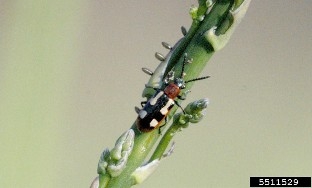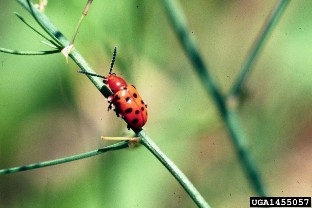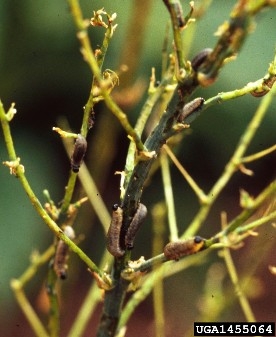Asparagus Beetles
ID
444-620 (ENTO-521NP)
Description
Two species of asparagus beetles are found in Virginia: the asparagus beetle, Crioceris asparagi (Figure 1), and the spotted asparagus beetle Crioceris duodecimpunctata (Figure 2). Asparagus beetles are in the leaf beetle family, formally known as Chrysomelidae. Adults of the asparagus beetle are ¼ inch (6.25 mm) long; their wing covers are metallic blue to black, with three or four white spots and reddish margins. The spotted asparagus beetle is about 1/3 inch (8.3 mm) long; it is orange and has 12 spots on its wing covers. Don’t mistake this little fella for a lady beetle (i.e., ladybugs, or Coccinellidae)! Look for spotted asparagus beetles to be slightly more elongate than their ladybeetle lookalike. Larvae of both asparagus beetles are olive green to dark gray, and have black heads and black legs. Larvae measure about 6/100 inch (1.5 mm) at hatching, and as they develop they become plump and attain a length of about 1/3 inch (8 mm). Both have eggs that are approximately 4/100 inch (1 mm) long; they are oblong, shiny, black, and are attached by one end to asparagus spears (Figure 1).


Damage
Adults and larvae chew on shoots and foliage (Figure 3). Eggs are laid on shoots around the time of harvest. Presence of eggs on the spears is objectionable to some, although the eggs themselves cause no damage.

Life History
Asparagus beetles overwinter as adults in plant debris. In spring, beetles feed on the tender asparagus spears and tips of buds, then deposit their eggs on spears. Eggs hatch in about one week, and larvae join the adults in feeding on the spears and ferns. After the larvae mature through four instars (approximately eight days), they enter the soil below and pupate. In five to ten days they will emerge as adult beetles. There are two generations per year in Virginia.
Cultural Management
Harvest spears as early as possible. Beetles are attracted to plants with an abundance of foliage; therefore, growers can leave a small portion of their crop unharvested as a decoy for beetles to congregate while the rest of the crop is harvested. Thoroughly remove all plant debris from the garden and surrounding areas after harvest to eliminate beetle overwintering sites.
Organics and Biologicals
Important natural enemies of asparagus beetles include a tiny parasitic wasp, Tetrastichus asparagi, which attacks eggs, and several species of lady beetles, which feed on eggs and small larvae. Keep in mind that treatment with insecticides, organic or synthetic, may reduce the contribution that natural enemies can provide to your pest management.
If you decide to apply an insecticide, spray or dust with botanical insecticides, such as those containing pyrethrins as the active ingredient. Apply treatments when larvae are first noticed feeding on plants. Since asparagus requires frequent harvests, be sure to consider the pre-harvest interval (PHI) located on the insecticide label. Some chemistries, even some organic insecticides, such as those containing spinosads, have long PHIs, which may not be ideal if harvest time is near.
Synthetic Chemicals
Treat with a registered insecticide when beetles begin to lay eggs, or when beetle larvae are feeding on the foliage. Again, since asparagus spears are harvested almost daily, it is important to use insecticides with minimal residual activity. Be sure to follow the necessary PHI between insecticide application and harvest. A second option is to apply a late-season insecticide application in the fall to reduce the beetle population before they overwinter. This may reduce the number of adults that successfully emerge from overwintering the following spring. On newly planted beds of asparagus, consider treating more frequently to protect the young plants, promoting vigorous establishment.
Virginia Cooperative Extension materials are available for public use, reprint, or citation without further permission, provided the use includes credit to the author and to Virginia Cooperative Extension, Virginia Tech, and Virginia State University.
Virginia Cooperative Extension is a partnership of Virginia Tech, Virginia State University, the U.S. Department of Agriculture (USDA), and local governments, and is an equal opportunity employer. For the full non-discrimination statement, please visit ext.vt.edu/accessibility.
Publication Date
September 29, 2022



